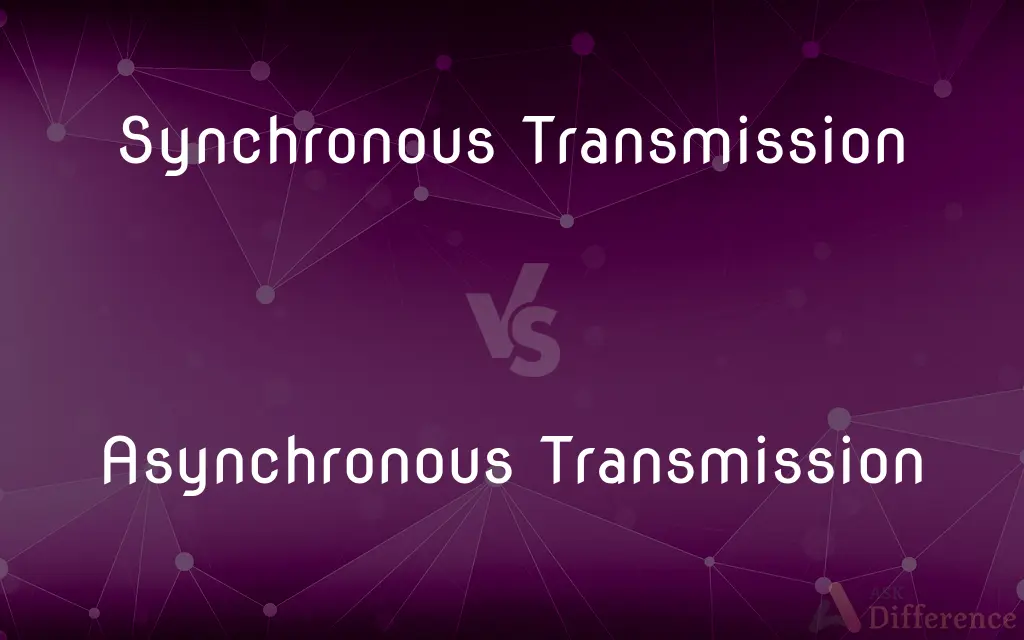Synchronous Transmission vs. Asynchronous Transmission — What's the Difference?
By Tayyaba Rehman — Published on January 4, 2024
Synchronous transmission is aligned to a clock signal, while asynchronous transmission occurs without such synchronization.

Difference Between Synchronous Transmission and Asynchronous Transmission
Table of Contents
ADVERTISEMENT
Key Differences
Synchronous transmission requires a shared clock signal between sender and receiver to coordinate the exchange of data, ensuring that the sender and receiver are synchronized. Asynchronous transmission does not require a shared clock, as data is sent in individual packets rather than a continuous stream.
In synchronous transmission, data is sent in a continuous stream, which can be more efficient for large volumes of data. Asynchronous transmission, however, is typically used for sporadic communication where data is sent in smaller, discrete packets.
Error detection in synchronous transmission can be simpler, due to the continuous nature of the data stream and the use of predetermined frame sizes. Asynchronous transmission requires start and stop bits to delimit each character, which can introduce more complexity in error detection.
Synchronous transmission often requires more complex hardware to maintain the timing between devices, making it more suitable for high-speed applications. Asynchronous transmission is simpler and more cost-effective for slower speeds or where data is sent infrequently.
Data transfer using synchronous transmission generally has less overhead because there are no start and stop bits as in asynchronous transmission. This means more of the bandwidth is dedicated to actual data, as opposed to data packaging and protocol.
ADVERTISEMENT
Comparison Chart
Timing
Requires clock signal synchronization
No clock signal; uses start/stop bits
Data Transfer
Continuous stream
Individual packets
Complexity
More complex hardware required
Simpler hardware
Efficiency
Higher for large volumes of data
Better for sporadic, less frequent data
Error Handling
Simpler due to frame synchronization
More complex due to packetization
Compare with Definitions
Synchronous Transmission
Requires matched timing between the sender and receiver.
The synchronous transmission ensured all devices were in sync.
Asynchronous Transmission
Asynchronous transmission sends data with start/stop bits without clock sync.
Serial ports commonly use asynchronous transmission for data transfer.
Synchronous Transmission
Synchronous transmission aligns data with a common clock signal.
High-speed networks often use synchronous transmission for efficiency.
Asynchronous Transmission
It is suited for intermittent communication between devices.
Keyboards typically utilize asynchronous transmission to send keystrokes.
Synchronous Transmission
It often features error-checking protocols based on timing.
Synchronous transmission's error correction relies on clock signal alignment.
Asynchronous Transmission
No need for synchronization, allowing flexibility in timing.
Asynchronous transmission is used for emails due to its non-real-time nature.
Synchronous Transmission
It sends data in a continuous, ordered sequence.
Synchronous transmission is crucial for real-time applications.
Asynchronous Transmission
It can handle variable data rates and start/stop transmission at any time.
Modems often employ asynchronous transmission to adapt to network conditions.
Synchronous Transmission
Synchronous transmission minimizes latency for streaming data.
Video conferencing relies on synchronous transmission for smooth communication.
Asynchronous Transmission
Asynchronous transmission is less efficient with bandwidth due to additional bits.
Despite overhead, asynchronous transmission is effective for simple data exchange.
Common Curiosities
How do devices start communication in asynchronous transmission?
Communication starts with a start bit and ends with a stop bit for each data packet.
Can asynchronous transmission handle real-time data?
It's less suitable for real-time data due to its start-stop nature and potential latency.
Can asynchronous transmission be used for distance communication?
Yes, it's often used for non-real-time communication such as emails.
What ensures synchronization in synchronous transmission?
A common clock signal between the sender and receiver ensures synchronization.
Why might a business choose synchronous transmission?
For applications requiring low latency and continuous data transfer.
Can synchronous transmission occur over the internet?
It can, particularly in dedicated high-speed networks with proper synchronization.
Is a clock signal necessary for asynchronous transmission?
No, asynchronous transmission uses start and stop bits instead of a clock signal.
What type of data benefits from synchronous transmission?
Large volumes of continuous data, like video streaming, benefit from synchronous transmission.
What's a primary advantage of synchronous transmission?
It allows for more efficient data transfer over high-speed connections.
What's easier to implement, synchronous or asynchronous transmission?
Asynchronous transmission is generally easier to implement due to its simplicity.
Do asynchronous transmissions require more bandwidth?
Yes, because of the additional start and stop bits, more bandwidth is consumed.
Are synchronous systems more complex than asynchronous?
Yes, synchronous systems are typically more complex due to the need for clock synchronization.
How does error detection differ between the two transmissions?
Synchronous uses timing-based error checking, while asynchronous uses parity checks.
Does synchronous transmission use start and stop bits?
No, synchronous transmission uses continuous streams of data without start/stop bits.
Is asynchronous transmission suitable for a stable, constant data stream?
No, it's better for sporadic or singular data packets.
Share Your Discovery

Previous Comparison
Insect Pollinated Flowers vs. Wind Pollinated Flowers
Next Comparison
Fulltime Study vs. Part Time StudyAuthor Spotlight
Written by
Tayyaba RehmanTayyaba Rehman is a distinguished writer, currently serving as a primary contributor to askdifference.com. As a researcher in semantics and etymology, Tayyaba's passion for the complexity of languages and their distinctions has found a perfect home on the platform. Tayyaba delves into the intricacies of language, distinguishing between commonly confused words and phrases, thereby providing clarity for readers worldwide.
















































